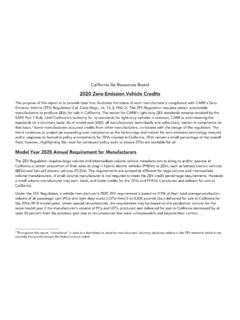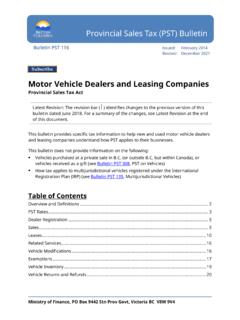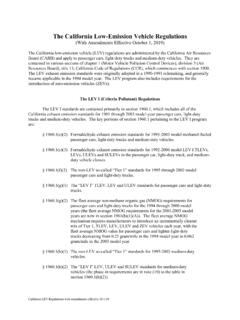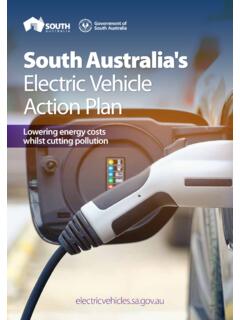Transcription of Special Report 05/2021: Infrastructure for charging electric …
1 EN 2021. 05. Special Report Infrastructure for charging electric vehicles: more charging stations but uneven deployment makes travel across the EU complicated 2. Contents Paragraph Executive summary I-IX. Introduction 01-13. Electricity at the forefront of alternative fuels in road transport 01-07. The EU's response to the chicken-and-egg' problem 08-13. Audit scope and approach 14-18. Observations 19-69. Despite more charging stations and harmonised plugs, the uneven deployment of charging Infrastructure means travel across the EU in electric vehicles is not easy 19-41. There are no clear and coherent EU-wide charging Infrastructure targets 20-24. The Commission has been unable to ensure that national plans are consistent and coherent from an EU perspective 25-28.
2 The charging network is growing, but there are significant differences in deployment across the EU 29-34. Common EU plug standards are being widely adopted 35-37. However, travel across the EU is still complicated by the absence of minimum requirements for harmonised payment systems and user information 38-41. CEF funding is promoting deployment, but the Commission has been unable to ensure that it goes where it is most needed 42-69. There has been no comprehensive Infrastructure gap analysis to support the setting of CEF priorities and project selection 43-56. The CEF is promoting deployment, but the projects we audited are not fully delivering on their objectives 57-69.
3 Conclusions and recommendations 70-80. 3. Annexes Annex I Share of EVs in total passenger vehicle fleet, EU-27 and UK. Annex II EV charging standards Acronyms and abbreviations Glossary Replies of the Commission Audit team Timeline 4. Executive summary I With the European Green Deal announced in December 2019, the EU is now aiming to reduce greenhouse gas emissions from transport by 90 % by 2050 compared with 1990, as part of a larger effort to become a climate-neutral economy. An essential part of reducing emissions from road transport is the transition to alternative, lower-carbon fuels. Of these, the most common new source is electricity, particularly for passenger vehicles.
4 II The deployment of charging Infrastructure in line with electric vehicle uptake is a key enabler of the switch to alternative fuels and to a largely zero -emission vehicle fleet by 2050. The ultimate policy objective is to make electric vehicle charging as easy as filling a conventional vehicle tank, so that electric vehicles can travel without difficulty right across the EU. To reach that aim, the EU faces the following interlinked problem: on the one hand, vehicle uptake will be constrained until charging Infrastructure is available, while on the other, investments in Infrastructure require more certainty of vehicle uptake levels. III The Commission has the role of steering the EU's overall alternative fuels policy.
5 The added value of EU action in this field is that alternative fuels Infrastructure is a trans-national challenge, but individual Member States do not have the necessary tools to achieve pan-European coordination. What the Commission can do is adopt common standards to ensure interoperability, coordinate and support Member States'. deployment of electrical charging Infrastructure , and monitor progress. Through the Connecting Europe Facility, moreover, it provides financial support for electrical charging Infrastructure . IV This Report will contribute to the forthcoming revisions of key EU legislation in this area and to the work of planning and implementing the 2021-2027 programme period.
6 It will help the Commission to support more effectively the deployment of publicly accessible charging Infrastructure across the EU, particularly in the context of the Green Deal objectives and the expected significant growth of electro-mobility (the use of electric vehicles) in the next few years. 5. V The objective of our audit was to determine the effectiveness of the Commission's support for the deployment of an EU-wide publicly accessible Infrastructure for charging electric vehicles during the 2014-2020 period. We looked at the way in which the Commission adopts standards, and coordinates and supports Member States'. deployment of electrical charging Infrastructure , and at how it manages CEF funding for electrical charging Infrastructure .
7 VI We obtained information from several sources, including the Commission, national authorities, beneficiaries of EU funding and other stakeholders. To gain first- hand experience as users of charging Infrastructure , we used an electric vehicle to visit and test a number of EU co-funded charging stations. VII We found that the Commission has succeeded in promoting a common EU plug standard for charging electric vehicles, and that users are gradually gaining more harmonised access to different charging networks. However, obstacles to travel across the EU in electric vehicles remain. Although the charging network is growing across the EU, deployment is patchy, as there are no clear and consistent minimum Infrastructure requirements to ensure EU-wide electro-mobility.
8 The EU is still a long way off its ambitious Green Deal target of 1 million charging points by 2025, and it lacks an overall strategic roadmap for electro-mobility. Travel across the EU is further complicated by the absence of harmonised payment systems with minimum requirements and adequate user information on real-time availability and billing details of charging stations. VIII EU financial support from the Connecting Europe Facility has been used widely to promote the deployment of interoperable charging stations across the EU. However, in the absence of a comprehensive Infrastructure gap analysis, the Commission has been unable to ensure that EU funding goes where it is most needed.
9 Moreover, it has not been making funding for charging stations conditional on a minimum period of operation, or on assurances of equitable access for all electric vehicle users. Every one of the projects we reviewed was affected by implementation delays and some delivered only partial outputs. Finally, we noted that the current rates of use of co-funded stations are generally low, which increases the sustainability risks associated with these investments. 6. IX On the basis of these conclusions, we recommend that the Commission should: o Propose minimum electrical charging Infrastructure requirements across the TEN-T network. o Prepare a strategic and integrated EU electro-mobility roadmap.
10 O Develop an Infrastructure and funding gap analyses. o Use the Infrastructure and funding gap analyses and clarified criteria to strengthen its selection of projects. o Include clauses in project grant agreements to ensure sustainable and equitable access to co-funded Infrastructure . 7. Introduction Electricity at the forefront of alternative fuels in road transport 01 With the European Green Deal announced in December 2019, the EU is now 1. aiming to reduce greenhouse gas emissions from transport by 90 % by 2050 compared with 1990, as part of a larger effort to become a climate-neutral economy. Transport accounts for approximately one quarter of all greenhouse gas emissions in the EU, predominantly (72 %) through road transport 2.



